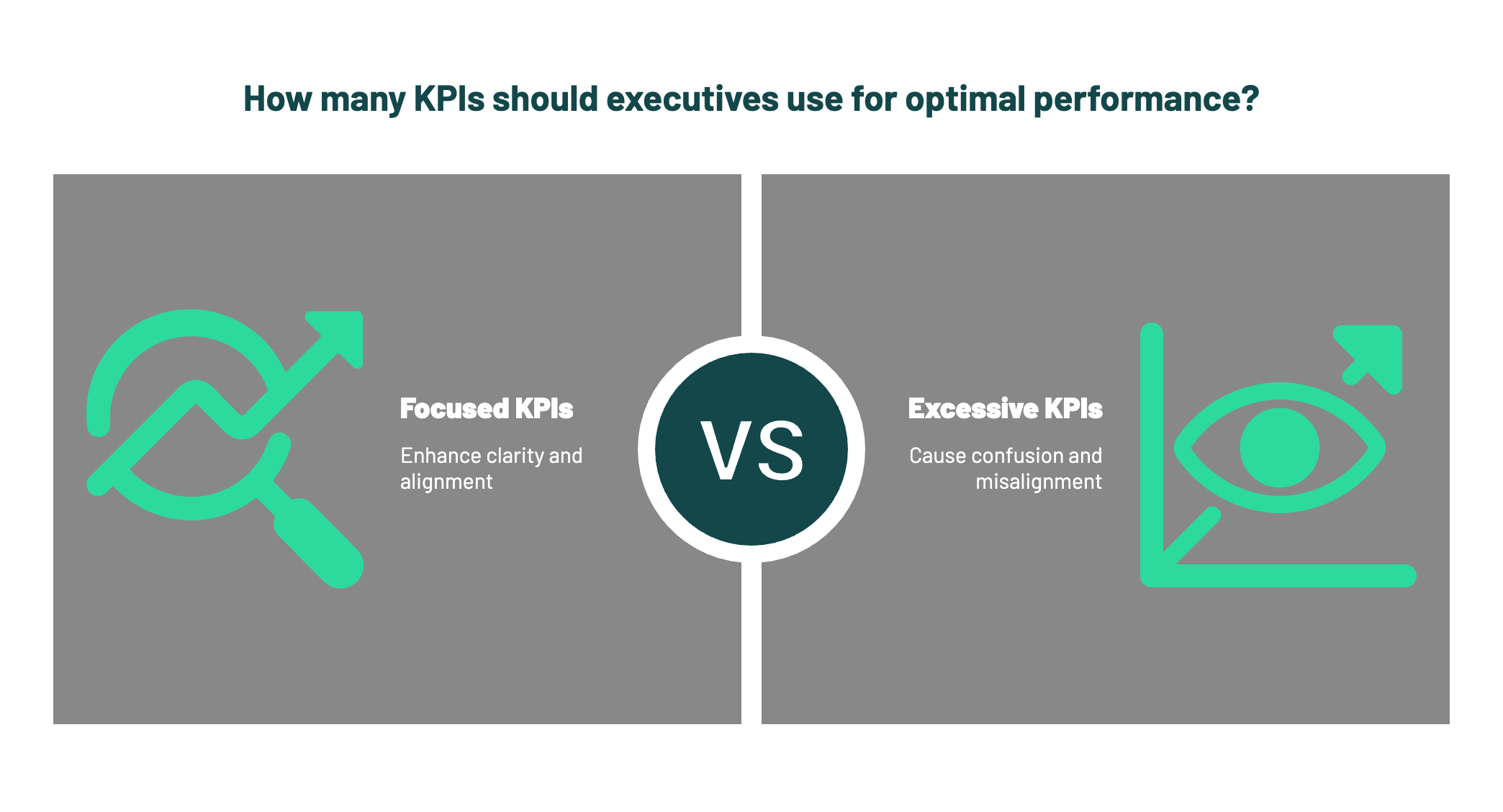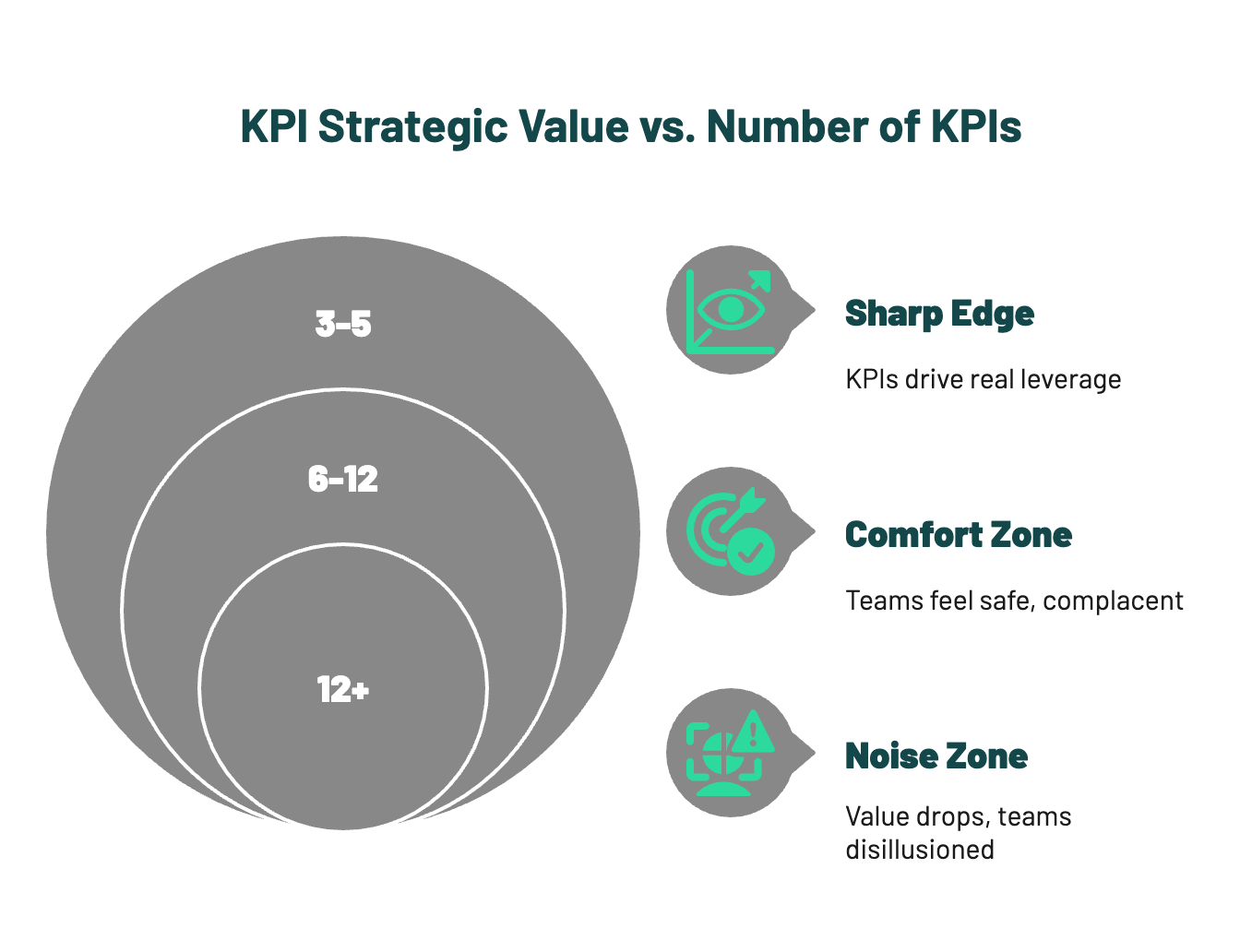Leadership
August 7, 2025
5
Min
Why Most KPIs Fail: Applying the Law of Diminishing Returns to Metrics
Leadership
|
Metrics matter. But research from Harvard Business Review shows that companies using more than 8–10 KPIs at the executive level actually see lower performance alignment than those who keep it focused. This isn’t a data problem. It’s a leadership problem.
The culprit is the law of diminishing returns. Just as pouring a tenth cup of water into a plant pot will drown the roots instead of nourishing them, every additional KPI after a certain threshold reduces clarity rather than increasing it. Leaders know this intuitively, yet quarterly board decks continue to swell with 30+ metrics.
The result? Teams lose focus, priorities blur, and measurement theatre replaces strategic action.

We frame this with what we call the KPI Return Curve. Think of it as three distinct zones on a graph plotting "number of KPIs" against "strategic value":
With 3–5 KPIs, organisations get real leverage. Each metric signals what truly matters, and progress feels visible. For example, a B2B SaaS company tracking only Customer Acquisition Cost, Net Retention, and Gross Margin can make trade-offs cleanly.
Reflection prompt: Which 3–5 measures would your organisation fight to keep if you had to discard all others?
Between 6–12 KPIs, most leadership teams feel safe. Everyone has their pet metric, every function feels represented, and nobody rocks the boat. The problem? This comfort zone breeds complacency. Metrics are monitored, but they rarely spark debate or decision shifts.
Micro-action: Run a 30-minute “KPI Audit” workshop and ask: Which of these are truly directional versus merely descriptive?
Beyond 12 KPIs, value drops steeply. Reports balloon, meetings slow down, and frontline teams become disillusioned by measurement overhead. One global bank we advised had 47 board-level KPIs; executives admitted privately they only trusted four of them.
Micro-action: Eliminate one KPI this quarter. Notice whether decision quality improves or declines.

So how do leaders operationalise this idea without slipping back into metric overload? Three steps help:


If your executive team were allowed only five KPIs for the next 12 months, which ones would survive the cut?
Which of your current KPIs actually trigger a resource reallocation when they move - and which are just reported?
When leaders respect the law of diminishing returns, reporting shifts from theatre to traction. We’ve seen organisations move faster in strategic pivots, cut meeting times in half, and strengthen trust across layers of the business. More importantly, it restores the signal-to-noise ratio that allows executive attention - the scarcest resource of all - to focus on the right problems.
This week, convene your leadership team and ask one blunt question: Which KPI would we drop if we had to? The act of debating this question surfaces priorities more effectively than adding the next “nice to have” measure.
Team SHIFT
Which of your metrics actually moves the business forward, and which ones simply eat your team’s energy? Every leadership team we’ve worked with has wrestled with this question. At first, a new KPI feels like a sharp compass. Then, after months of reporting, it dulls into background noise. The paradox is that the more KPIs organisations set, the less useful they often become.
Metrics matter. But research from Harvard Business Review shows that companies using more than 8–10 KPIs at the executive level actually see lower performance alignment than those who keep it focused. This isn’t a data problem. It’s a leadership problem.
The culprit is the law of diminishing returns. Just as pouring a tenth cup of water into a plant pot will drown the roots instead of nourishing them, every additional KPI after a certain threshold reduces clarity rather than increasing it. Leaders know this intuitively, yet quarterly board decks continue to swell with 30+ metrics.
The result? Teams lose focus, priorities blur, and measurement theatre replaces strategic action.

We frame this with what we call the KPI Return Curve. Think of it as three distinct zones on a graph plotting "number of KPIs" against "strategic value":
With 3–5 KPIs, organisations get real leverage. Each metric signals what truly matters, and progress feels visible. For example, a B2B SaaS company tracking only Customer Acquisition Cost, Net Retention, and Gross Margin can make trade-offs cleanly.
Reflection prompt: Which 3–5 measures would your organisation fight to keep if you had to discard all others?
Between 6–12 KPIs, most leadership teams feel safe. Everyone has their pet metric, every function feels represented, and nobody rocks the boat. The problem? This comfort zone breeds complacency. Metrics are monitored, but they rarely spark debate or decision shifts.
Micro-action: Run a 30-minute “KPI Audit” workshop and ask: Which of these are truly directional versus merely descriptive?
Beyond 12 KPIs, value drops steeply. Reports balloon, meetings slow down, and frontline teams become disillusioned by measurement overhead. One global bank we advised had 47 board-level KPIs; executives admitted privately they only trusted four of them.
Micro-action: Eliminate one KPI this quarter. Notice whether decision quality improves or declines.

So how do leaders operationalise this idea without slipping back into metric overload? Three steps help:


If your executive team were allowed only five KPIs for the next 12 months, which ones would survive the cut?
Which of your current KPIs actually trigger a resource reallocation when they move - and which are just reported?
When leaders respect the law of diminishing returns, reporting shifts from theatre to traction. We’ve seen organisations move faster in strategic pivots, cut meeting times in half, and strengthen trust across layers of the business. More importantly, it restores the signal-to-noise ratio that allows executive attention - the scarcest resource of all - to focus on the right problems.
This week, convene your leadership team and ask one blunt question: Which KPI would we drop if we had to? The act of debating this question surfaces priorities more effectively than adding the next “nice to have” measure.
Team SHIFT
Which of your metrics actually moves the business forward, and which ones simply eat your team’s energy? Every leadership team we’ve worked with has wrestled with this question. At first, a new KPI feels like a sharp compass. Then, after months of reporting, it dulls into background noise. The paradox is that the more KPIs organisations set, the less useful they often become.
Metrics matter. But research from Harvard Business Review shows that companies using more than 8–10 KPIs at the executive level actually see lower performance alignment than those who keep it focused. This isn’t a data problem. It’s a leadership problem.
The culprit is the law of diminishing returns. Just as pouring a tenth cup of water into a plant pot will drown the roots instead of nourishing them, every additional KPI after a certain threshold reduces clarity rather than increasing it. Leaders know this intuitively, yet quarterly board decks continue to swell with 30+ metrics.
The result? Teams lose focus, priorities blur, and measurement theatre replaces strategic action.

We frame this with what we call the KPI Return Curve. Think of it as three distinct zones on a graph plotting "number of KPIs" against "strategic value":
With 3–5 KPIs, organisations get real leverage. Each metric signals what truly matters, and progress feels visible. For example, a B2B SaaS company tracking only Customer Acquisition Cost, Net Retention, and Gross Margin can make trade-offs cleanly.
Reflection prompt: Which 3–5 measures would your organisation fight to keep if you had to discard all others?
Between 6–12 KPIs, most leadership teams feel safe. Everyone has their pet metric, every function feels represented, and nobody rocks the boat. The problem? This comfort zone breeds complacency. Metrics are monitored, but they rarely spark debate or decision shifts.
Micro-action: Run a 30-minute “KPI Audit” workshop and ask: Which of these are truly directional versus merely descriptive?
Beyond 12 KPIs, value drops steeply. Reports balloon, meetings slow down, and frontline teams become disillusioned by measurement overhead. One global bank we advised had 47 board-level KPIs; executives admitted privately they only trusted four of them.
Micro-action: Eliminate one KPI this quarter. Notice whether decision quality improves or declines.

So how do leaders operationalise this idea without slipping back into metric overload? Three steps help:


If your executive team were allowed only five KPIs for the next 12 months, which ones would survive the cut?
Which of your current KPIs actually trigger a resource reallocation when they move - and which are just reported?
When leaders respect the law of diminishing returns, reporting shifts from theatre to traction. We’ve seen organisations move faster in strategic pivots, cut meeting times in half, and strengthen trust across layers of the business. More importantly, it restores the signal-to-noise ratio that allows executive attention - the scarcest resource of all - to focus on the right problems.
This week, convene your leadership team and ask one blunt question: Which KPI would we drop if we had to? The act of debating this question surfaces priorities more effectively than adding the next “nice to have” measure.
Team SHIFT
